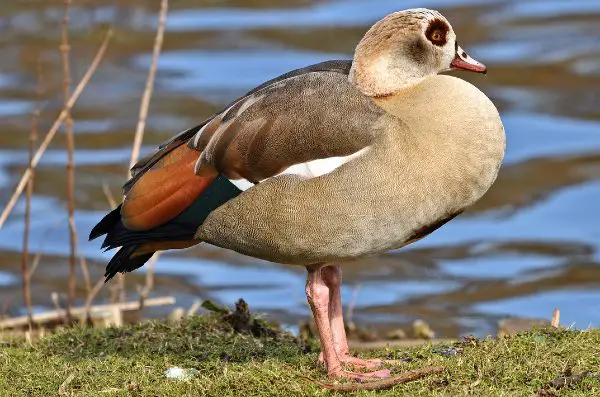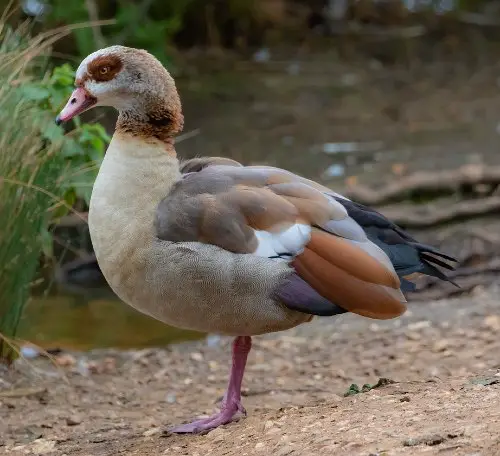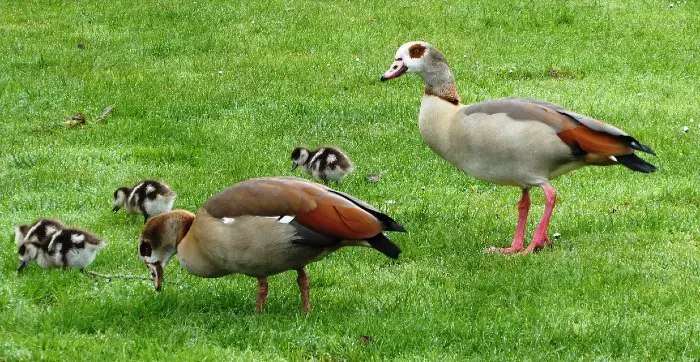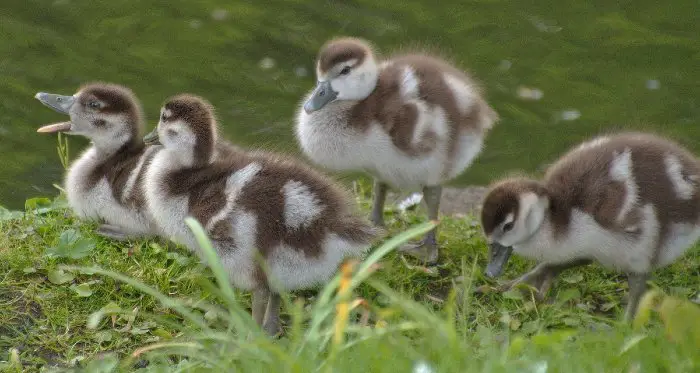The Egyptian Goose is one of the oldest domesticated geese breeds in the world. In fact, it has been around since the times of Ancient Egypt. While this is not really a productive breed of goose, it is surprisingly common throughout the world, mostly as an ornamental breed. We want to talk a little bit more about the Egyptian Geese on this page.

The Origins of the Egyptian Goose
The Egyptian Goose is a direct descendant of the wild Egyptian geese, they were prominent in Ancient Egypt. This means that this goose is over 1,000 years old, at the very minimum. They were domesticated by the ancient Egyptians and were kept as guard birds.
Over the years, the Egyptian Goose has spread throughout the world, with populations both wild (more on this soon) and domesticated being found in a variety of different countries.
It can be found just about anywhere in Africa (outside of deserts), and in most major countries throughout Europe where it was imported a few centuries ago.
While most Egyptian Geese that are bred purely to be ornamental are critically endangered, the Egyptian Goose has managed to maintain a good amount of its popularity and is unlikely to be going extinct any time soon.
The Egyptian Goose was first admitted to the APA in 1874.
The Look of the Egyptian Geese
The Egyptian Goose is brown and grey, with many of these birds having green feathers near their back. They will have dark rings around their eyes.
A lot of people will actually confuse the Egyptian Goose for the duck. This is because it is more closely related to the shelduck than other goose breeds.
In fact, nearly everything about the way the Egyptian goose moves, would make you think that this is a duck, but we promise you that it isn’t!

The unique look of the Egyptian Goose is why it is so popular as an ornamental breed in many countries of the world.
As a Show Goose
As we have stated several times on this page, the Egyptian Goose is pretty much only a show bird. While it can be productive in some areas, it is mostly used for show purposes.
As a result, you should be able to find regular goose shows operating in most major countries that allow this bird to enter.
It is also raised as an ornamental bird, which has actually caused issues for many countries. Because it is never culled, and often given free reign to wander around the land it is on, there have been a lot of escapees.
As a result, a lot of countries have started to develop wild populations of the Egyptian Goose. This is especially bad in the United Kingdom, where it is said that the number of wild Egyptian Geese outweighs those being raised domestically.
They are causing serious issues for the environment, and since they are an invasive species, people are allowed to freely shoot them in the wild without a license. Although, this is unlikely to be having a major impact on the breed.
This, of course, does mean that you may suffer an issue or two if you decide to raise them as an ornamental breed of goose. They are prone to escaping, sadly.
The Egyptian Goose Eggs and as an Egg-Laying Breed

This goose lays around 20-30 eggs per year. Although, they are never really raised for their egg production. The egg production is more going to be a ‘side benefit’ of them being an ornamental breed.
As you can imagine, since this is a breed of duck that has managed to take the wild by storm, it is going to be very easy to breed. You do not have to do anything special.
Just leave this bird to their own devices and they will breed (assuming that you have both males and females, obviously). They are very broody animals, and they are highly fertile.
Of course, due to their high fertility, it can mean that your population of geese may get out of control if you leave them unchecked. As a result, a lot of people will only raise the female version of the goose.
These are long-lived species, so assuming that you are using them for ornamental purposes only, there will be no constant replacing of the bird. There really is no need to breed these personally unless you want to increase the size of your flock, or you plan on selling the bird on.
The Egyptian Goose For Meat
Again, this is not really something that the Egyptian goose is raised for. However, we see no reason why this couldn’t be a meat bird.
The only real thing standing in its way is the fact that it is a bit on the smaller side. However, even though it is on the smaller side, this is still a substantially large animal and should still give a few decent meals.

Raising the Egyptian Goose
You do not really need to do all that much if you want to raise this bird. It is dead simple to do. It could thrive on its own, even if you only gave it food and water each day.
The one issue you may have is the fact that this goose is known for being territorial. Also they are the most aggressive and bad-tempered breed during the breeding season.
It is not necessarily an aggressive bird, but you probably do not want to be petting it all too often.
It is the males that do seem to be a bit more on the aggressive side, though. If you have females, and they are not raising their young, then these birds can be quite friendly.
Of course, due to their territorial nature, you shouldn’t really be combining these with other breeds of goose, or even trying to raise too many males. There will be fights that break out, and a few of these fights can end up being deadly!
Finally; these birds can ‘escape’ often. As a result, you will want to try and devise ways that you can keep them on your property.
However, sadly, no matter what you do, you will inevitably end up with a few escapees on occasion. There is absolutely no way to prevent that.
See also: Pilgrim Goose


Pingback: Guide to Goose Breeds - List Of All Domestic Breeds of Geese in US